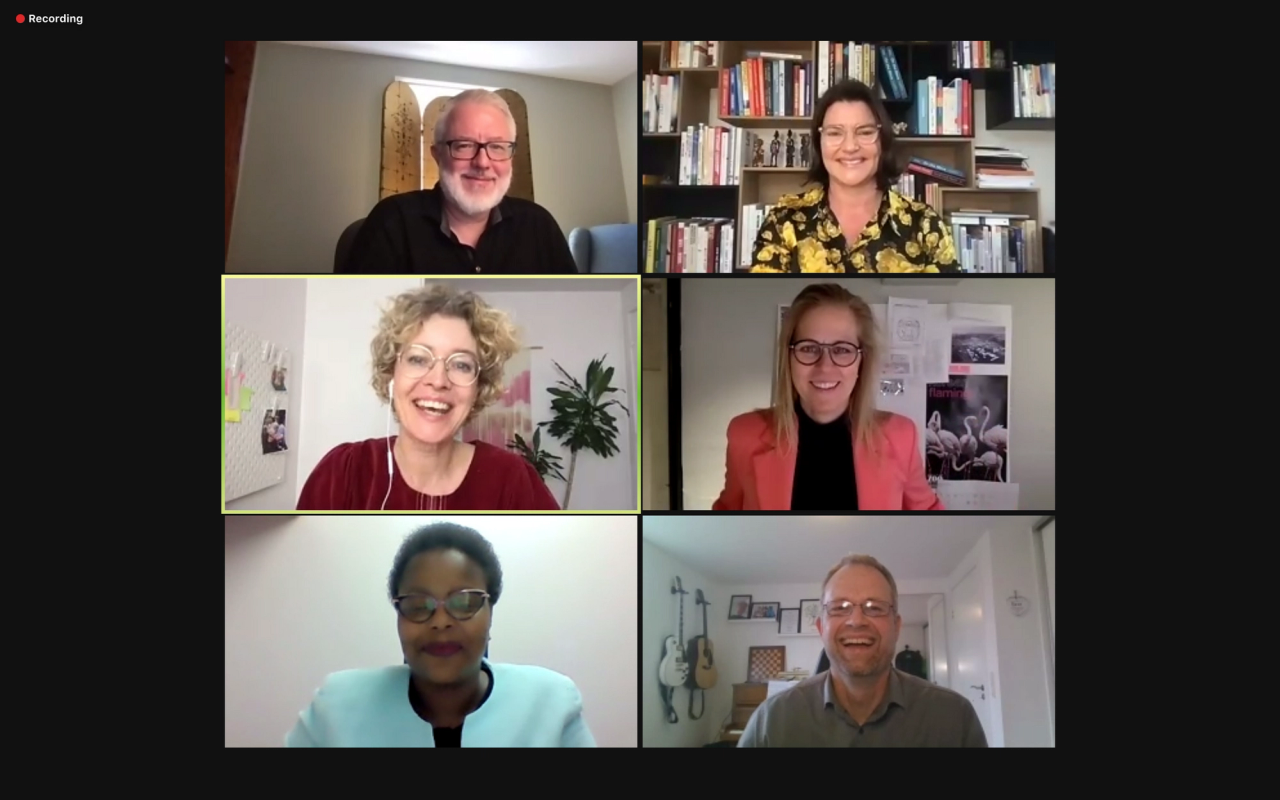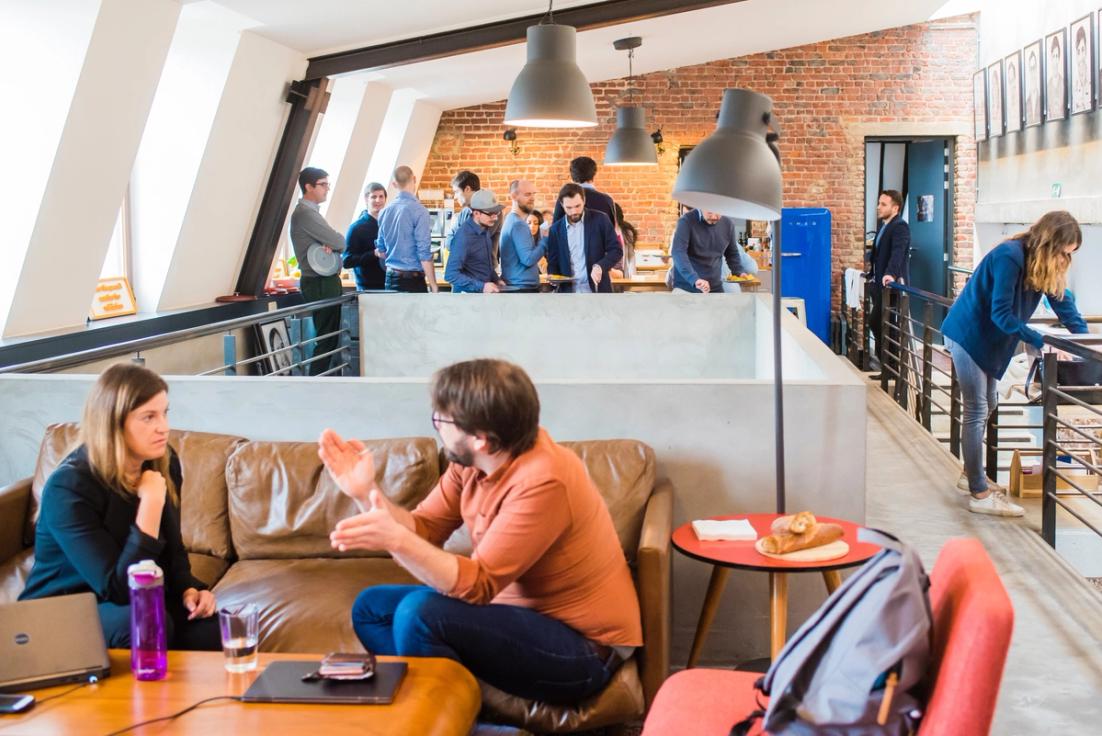On March 24th 2021, Session celebrated the launch of our new platform connecting professionals with great coaches all over the world. To kick things off, we held a Webinar on the topic of “Working and Lading in a Fast-Forward World” with a diverse panel and moderated by Astrid Haug, a leading digital transformation expert.
In this article, we walk you through the main highlights and learnings from the Webinar. We digest what was discussed, help you understand some of the trends happening in modern workplaces and identify what leaders can do to make sure their teams not only survive, but thrive in a fast-forward world.
Introduction
Working and leading in the 21st century can be confusing and complex with so many things happening at lightning speed. As we know, everything can change in an instant, and just as you figure out exactly what to do, how to do it and how to apply your strengths - something new happens that forces you to rethink and reinvent. These changes may extend to you, your business model, the way you are organized, who you collaborate with - and how. Moreover, our work has now moved online meaning we also need to figure out how to work, lead and thrive in a digital world.
On the 24th of March, a panel consisting of professionals from all over the world working in different industries discussed:
- what it takes to not only survive, but thrive, in modern work life,
- how to create flourishing enterprises in a fast moving, ever changing and uncertain working environment and;
- what challenges and opportunities the virtual working environment presents us with.
Panelists
- Martin Gert Hansen, General Manager, Novo Nordisk A/S
- Malene Ratcliffe, CEO, Superflex
- Sheila Kariuki, Founder, Resource Associates Limited
- Eric Knauf, VP of Talent & Culture, Advisor & Coach, Organizational Builder
Motivation, Sense-Making and Purpose
The first topic explored by the panel was motivation. Martin wasted no time in opening our discussion by stating, that:
“If you think you need to motivate people, you already lost the game…”
This led to an interesting debate about the topic of motivation and who is responsible for it. Is it the responsibility of the leader to keep people motivated throughout their career, or not? Tons of articles and books on leadership have been written about motivation through the years and it has been widely accepted that motivating employees is a crucial leadership task.
Yet here we are right at the beginning of the Webinar, with Martin claiming you have lost the game if you think you need to motivate your team?
As it turned out that he might just have a point. CEO of Superflex, Malene elaborated that:
“If people are not motivated, I - as the leader - need to ask myself “Oh my G… what did I do wrong... I must have ruined something”.
The fact is, that people show up at work motivated right from the beginning.
“As a leader you do not need to take care to motivate people, you need to take care not to demotivate them!”
From the very outset, things need to make sense to people. You cannot hope to motivate people in a situation that does not make sense from the beginning. So, as a leader, more important than “motivating” is to remove barriers and friction preventing the team from getting things done.
This opening exchange led to healthy debate with our audience digging deeper. They wanted to know about the connection between purpose and motivation. Undoubtedly, a very valid question. Leadership literature has grappled extensively with the “Why”. ‘Start with Why’ by Simon Sinek, talks about how having a great vision and a clear purpose will help people stay motivated, engaged and will attract people to work for the organization in the first place.
The latter might be true (that people are attracted to organizations with a grand vision and mission). However, recent research shows that a grand vision is not what will keep people motivated on a daily basis. Rather, it is whether employees feel that they progress in meaningful work each day or not.
As Eric Knauf added:
“Maybe we spend too much time talking about the why? The question is - how do we personalize the why? We need to personalize the why, speak to each and everyone's hearts and make sure people know what to do and then make room for them to be able to act on their own”.
On the topic of motivation, Malene added:
“We all have the responsibility to inspire each other. It is not only the leader that needs to motivate others. We all need to keep each other inspired and motivated”.
Bringing your whole self to work - meet people where they are - be emotionally intelligent
Building on the theme of motivation was the concept of “bringing your whole self to work”. When things are happening at a lightning pace, we might sometimes forget to look at each employee, colleague and leader, as their own, unique selves. However, this was something everyone on the panel agreed was vitally important to create a thriving work environment.
Eric: “How do we enable people that are passionate about what they are doing, to bring their whole self to work? All of us show up with a set of competencies that come out and manifest themselves in behavior. But if this is not aligned with who they are as a person, things tend to fall apart… What we need to do is to double down on people's strengths. That is where people are going to flourish and find success. So, as leaders, we should ask ourselves: Are we allowing the people that are reporting up to us to be uniquely human? Do we allow them to bring their whole self to work?”
Sheila, Founder at Research Associates, built on this idea adding:
“We all have to learn to work in this new reality, where managers are responsible for teams, for other people, in many cases now have to lead in a virtual environment. Each leader has to take into consideration the unique situation that their team members are in. The need to be emotionally intelligent (as a leader) has just been heightened. As a leader, appreciating the challenges that everyone is going through and responding to that (in an appropriate manner), is very important.”
So, in order to build an environment where our employees can really thrive, we need environments where:
- People are met “where they are” and there is an understanding of each and everyone's unique situation.
- Employees are allowed and encouraged to be “their whole, unique selves” and valued for their strengths and contributions.
- It is ok for people to show weaknesses, vulnerabilities and admitting mistakes (this is also named “Psychological Safety” by Amy Edmondson).
As the conversation progressed a question from the audience emerged:
“What are the potential risks of being yourself, in a workplace that traditionally doesn´t encourage that? I talk to a lot of young people who fear showing their weaknesses and vulnerabilities because they fear missing out on the promotion, pay rise or projects they want to work on. How can you work with the systems and leaders, to create space for being a whole human at work?”
We can recognize this dilemma from many of the sessions our coaches have with clients at Session. It might sound “right” to bring your whole self to work, admit weaknesses and mistakes, but what if it doesn't pay off? What if it could actually be punished?
Unfortunately, this happens! There are two things (at least) you can do in situations where people are punished (or perhaps “just” ignored or looked down upon) for showing vulnerability or admitting mistakes - or for “just being themselves”:
- Call it out - not only to yourself, but also when it happens to others. Calling things out identifies a problem and highlights that there are other ways of doing and looking at things - and that these “other ways” might in fact be beneficial to not only the individual, but also to the organization as a whole to work towards. However, calling things out takes courage. This is why Dr. Brene Brown, a leading researcher within vulnerability, called her leading book on the topic “Dare to Lead”.
- Walk the talk yourself. Show your whole self. Admit mistakes. Show others that you can’t “die” from showing vulnerability and admitting mistakes. In fact, it might pay off. Perhaps your expectation that this will be punished and not valued is all wrong? And if not, how can you build the argument for this to be something that deserves to be valued? What are some good reasons and what is the “business case” for building an environment, where showing vulnerability and admitting mistakes and bringing your whole self to work?
Diversity
Our panel discussion then turned toward the topic of diversity and the importance of building diverse teams. Our experts explained that diversity impacts everything from creating an environment for innovation, performance and high employee satisfaction.
Malene stirringly explained:
“Just as the planet needs biodiversity, so does a workplace”.
This prompted Eric to further illustrate that:
“There is magic in disperse ideas. When you bring different people together, whether it is HR versus sales, or liberal versus conservatives, or old school versus new school, the greater the disparity, the greater the diversity of ideas you have in the room. So, it is important for the manager to not only recognize the competences that people bring to the table, but also their different viewpoints and personalities.”
Managers must allow differences in viewpoints to be brought out in the open and not shy away from conflict. It is not enough for the manager to “just” make sure that there is diversity in the team and the organization as a whole . The differences in opinions must be valued and seen as assets, rather than threats.
This viewpoint is supported by the eminent Amy Edmondson. Dr. Edmondson has spent a lifetime researching the importance of psychological safety in the workplace. She explains the deep correlation between engagement, productivity, innovation - and how safe people feel at work. If the team does not feel safe, they will not speak up, and they will not call it out when there is a problem. Naturally, this inevitably impacts the quality of work and productivity when problems are not efficiently addressed. When people feel safe and secure, they dare to bring out different ideas, perspectives and opinions and can speak candidly when they need feedback or have concerns.
At Superflex, where Malene is CEO, they deliberately try to bring in different perspectives to make sure their products/art are more interesting, of higher quality and relevant to the audience. To do this, they have two guiding principles, which Malene enthusiastically explained: “Celebrate Friction” and “Expand”. These principles guide them to deliberately engage in conflict, give voice to voices that normally aren't heard and to bring in perspectives from different sources - including fish! As they say in the studio:
“The best idea may come from a fish!”
Think about that for a moment… By stating that the best idea may come from a fish, you push the boundaries for what you normally think you can learn from. We usually listen to those around us, and if pushed, we might also try to listen to our opponents. But - if you listen carefully, even to a fish for example, you train your ability to be empathetic and see things from a different angle and a completely different perspective. What happens if you try to see the world through a fish' eyes? How would you act, build, meet other people (and interspecies) if you had to take their perspective into consideration?
By allowing people to be themselves, bringing their whole selves to work and play to their strengths - you expose a variety of different strengths, competencies, perspectives and personalities. People are taught to listen to and respect each other's opinions and see the value in differences, celebrate friction as part of building a successful culture. This is the recipe for success, innovation and a working environment where everyone can flourish.
Vulnerability and not having all the answers (is it ok?)
But what if you don’t know how to do this? What if you do not know how to bring your employees strengths to work? How can you build a team of people with different backgrounds and allow them to discuss, debate and sometimes even fight their way toward the best solution?
What if you do not know how to listen to a fish?
Furthermore, what if you feel insecure as a leader, and your authentic self is very vulnerable, insecure and confused at times? Is this ok as a leader? What if you do not have a clear answer when your employees and others are expecting one from you?
This last question was exactly what our webinar audience wanted to know too. Sheila replied:
“As executives, there is a lot of pressure to find solutions and come up with answers. And right now, we are living in a VUCA world, there is a lot of ambiguity and uncertainty, and as leaders, as executives, we do not always have the solutions. But there is so much pressure for us to give the solutions. And we are sitting here and thinking to ourselves, now, what am I going to do with this, what am I going to tell the team, and there is no one really to bounce back ideas and thoughts upon. But it is really usually a matter of trust. Being able to trust somebody to talk to and tell what your concerns and fears are…”.
Eric built on this answer adding:
“I do not believe people are actually looking for a bold answer. What they are looking for is an answer that touches them personally. But ultimately, what you need to do (as a leader/manager) is to create a democratized work environment where individuals can come up with solutions themselves, as opposed to just the leader finding the solutions. There is only so much grey matter to go around, and those of us that lead individuals, I would like to think that I have all kinds of great ideas, but guess what - I only have some ideas…and they are not all great... I have found that the best ideas come from those that I work with. So rather than being top-down, rather than being highly autocratic, you need to give individuals the opportunity to bring their ideas forward”.
And to pin it down, Martin concluded:
“For every complex problem there is an answer that is clear, simple, and wrong” (quote by Mencken).
So, what the panel points out is that we might want clear answers, but it is totally ok for the leader to not necessarily to have one right away. What the leader then needs to do, when feeling insecure and vulnerable, is to take a time out and find someone, s/he can trust and talk things through with. This might be a colleague, a mentor or a professional coach. Then, the leader might find some clarity and a solution or an idea of how to move forward. However, even without this breakthrough, it can always work to include the team and be honest. Involve them and ask them what they think the answer is, or what might be the best next step to take.
The only thing that needs to be clear is the vision and the strategic intent. This - the leader must have the answers to. But exactly how do you execute collaboratively? The leaders should help the employee figure this out, not TELL them what to do. This is the leadership of the new world. Leadership that dares to set the direction, and dares to involve people in how to “get there” - like Brene Brown and Stephen Bungay both call out.
Finding harmony, not balance
In line with the theme of not necessarily having all the answers, was the attempt to “find balance” in this fast-forward moving working world we are living in. Sheila opened this area of discussion by taking a holistic view:
“You need to work on integrating all aspects of your life. There is family, there is work, there is social, and other aspects in your life too. If you work with balance, one is going to lose, either work is going to lose, or family is going to lose, or social. So, you can really never get a balance - but you can get some harmony.”
Martin extended this harmony to maintaining presence and flexibility in understanding what works in the now:
“It's really about being present. You need to stay present in the moment to really figure out what to do. Stay still - see the situation from the outside perspective, take a good look, let the water settle and become clear, then you will know what to do. And can start experimenting. Don't think what is needed is a strategic plan going five years forward. Rather, make small experiments, get feedback, learn from them and pivot if needed. And go with what is easy - this is where the harmony is. And it is ok that things are easy, that is because you have removed the friction, and friction usually is there, when things do not make sense to people. So, harmony arises, when friction is removed and people are allowed to do things, that make sense to them, and find a way to get harmony in their work-life. If you should choose just one thing to be coached on, btw, this should be it - how to find balance and harmony in your work-life”.
Just as before, Martin seemed to poke at the truth of the matter as our audience was very much in alignment. According to our poll, they believed the biggest challenge to this fast-forward world was “work-life balance”.
Embracing the online
The final topic of discussion was the “challenges and opportunities” of the enforced virtual working environment.
Like it or not, the online universe is here to stay. It was widely agreed that human face to face contact is nice, needed and missed. However, it was also agreed, by panel and audience, that the online universe possesses some great opportunities for us all. In the poll introduced at the beginning of the webinar, we asked: “What is the biggest opportunity of modern work life?” And the highest scoring answer was: “Flexibility in work hours and from where you work.” Nothing facilitates this and many other opportunities quite like remote work.
Ironically, had it not been for the migration to the online universe, our first webinar would not have gathered so many people from all over the world. We also would not have been able to offer coaching to so many people at a lower cost with Session without the acceptance of virtual delivery. Our service of online coaching is democratizing coaching.
As the days tick by and our expectations for virtual service delivery continue, the tools we use will continue to develop. Visuals and audio will improve, connection barriers will reduce, and internet speeds will increase. Our opportunities will continue to grow the further into the online realm we go.
It was also discussed how the online world, while initially posing some limitations, has given us the opportunity to rethink and reinvent how we work together. A stunning example of such reinvention is the Nordic Dogme Film movement. Nordic Film Makers have embraced the limitations and restrictions and found novel and innovative ways to create new films. Similarly many of our panelists discovered new and innovative ways of working together - despite the perceived limitations. They have leveraged their positions to find new methods of collaborating in the working world.
Sometimes it takes a crisis to reinvent the world. The pandemic has certainly speeded up what would otherwise have taken years, perhaps centuries to happen. It has given us the possibility to work across borders, be less bound and stressed by travel and jet lag. We have become more open to our nearby surroundings and communities yet we continue to discover new friends, colleagues and inspiration from people from all around the world - just as happened at this webinar.
Summing up
This was the first ever Session Webinar. With success and attendance, we now plan to host an inspiring webinar every quarter. We will gather a thought-provoking panel of professionals who can share their experience and insights from working and leading in the modern world. We will dig into different relevant themes of leadership and organizational life with occasional insights into the world of business coaching.













